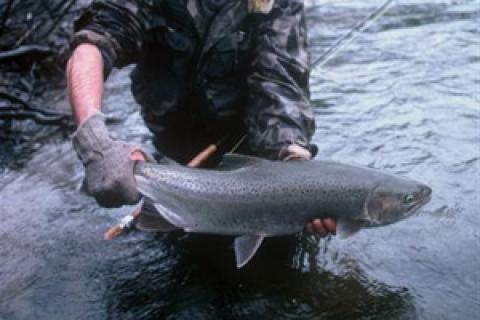
 It's hard to think of a single more productive pattern for catching trout, salmon and steelhead in winter and early spring than an egg fly. This is particularly true where strong runs of these coldwater fish occur, making eggs an abundant food source.
It's hard to think of a single more productive pattern for catching trout, salmon and steelhead in winter and early spring than an egg fly. This is particularly true where strong runs of these coldwater fish occur, making eggs an abundant food source.
One of the most important decisions in buying or tying an egg fly is what size you want. In the past multiple egg flies were popular. This system involves tying egg clusters on monofilament and then attaching them to the hook so that three or four small eggs can be presented like a gob of eggs.
In large rivers or with very big fish such as salmon, this is often a good bet. For most situations, though, a single egg is preferable. Size 4-12 short-shank hooks are standard. You can weight the hook shank with lead, but for a more natural presentation and fewer hang-ups, tie the flies un-weighted and add split shot 12 inches up on the tippet.
Larger flies — 4 to 6's — are best for big fish or turbid water. For clear water, go with size 8-12 hooks. The more pressure the water gets, the smaller the eggs you should use.
Egg color varies widely. Over 30 colors of yarn used to tie egg flies are offered. The best bet is usually to match the most common natural eggs where you fish. If you don't know that, try orange, peach, pink, yellow, olive and chartreuse. Over the years I've caught more fish on peach than all other colors put together, but it still pays to be flexible.
Egg yarn spun and trimmed to an oval shape on a plain hook is usually the best offering. At times, though, adding dressings can increase the effectiveness of egg flies. Try a few strands of marabou, Krystal Flash or similar material around the front for a collar or a short tail. This added bit of flash can help, especially if the water is slightly cloudy. Bead head egg flies are another option. These sink especially well for deeper waters.
Tackle for fishing egg flies should consist of an 8-9 foot rod and light reel spooled with backing and a size 4-6 floating line, weight forward or double taper. To this add a 9-12 foot leader tapering to a 3-5X tippet with a strike indicator near the top of the leader.
In deep water, fast sinking tip lines or shooting heads can be used, but often just a few split shot will provide sufficient weight. You can crimp these directly to the tippet or tie in a tiny barrel swivel where the tippet connects to the rest of the leader and leave the tag end of that knot long enough to attach the shot to. That way the lead will pull off if it hangs up without the fly breaking off.
Cast upstream and quartering across. Allow the fly to drift just like a real egg would — tumbling naturally along the stream bottom without drag or manipulation. You can false cast when necessary, but sometimes the best tactic is to just work the fly back close then lob out roll casts upstream. Keep the rod tip pointed at the fly as it works down in the flow through deep runs, pools and tail-outs.
Strikes will often be subtle. But once you tighten the line and the hook drives home, the fight of a muscular steelhead or burly salmon will be anything but gentle.
- 7250 views

